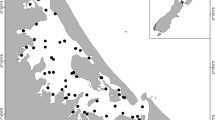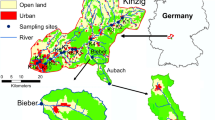Abstract
Macrobenthic community responses can be measured through concerted changes in univariate metrics,including species richness, total abundance, and totalbiomass. The classic model of pollution effects onmarine macrobenthic communities recognizes thatspecies/abundance/biomass (SAB) curves varydistinctively in a nonlinear manner with the magnitudeof organic enrichment. For example, at moderatelevels of organic enrichment, small-bodiedopportunistic species boost the abundance curve, whilespecies richness falls. Ratios among the metrics formuseful indicators of how the community changes withorganic enrichment. However, the classic SAB model isbased on organic enrichment effects over small spatialand temporal scales, and the applicability of the SABmodel to sediment chemical contamination and acrossbroad natural estuarine gradients is largely unknown. Here, SAB responses were examined with respect toprimary gradients in metals and organic chemicalsbased on an extensive dataset comprising 319 estuarinesites from throughout the northern Gulf of Mexico. Each SAB metric was first adjusted with respect to thethree primary natural estuarine gradients, salinity,depth, and sediment silt/clay content. Adjusted SABrelationships varied in their details with respect todifferent classes of sediment contamination, but alltypes of SAB stress responses appear to exhibitsimilar basic characteristics. As in the SAB model,all three SAB metrics were notably low at the highestconcentrations of both metal and organic-chemicalcontaminants. Moreover, rapid decreases in the B/Aratio with increasing contamination supported theconcept that relatively long-lived, large-bodied,equilibrium taxa decline markedly at highconcentrations of toxicants.
Similar content being viewed by others
References
Boesch, D.F. & R. Rosenberg, 1981. Response to stress in marine benthic communities. In: G.W. Barret & R. Rosenberg (eds), Stress Effects on Natural Ecosystems. John Wiley & Sons, New York, pp. 179–200.
Cairns, J. Jr., B.R. Niederlehner & E.P. Smith, 1992. The emergence of functional attributes as endpoints in ecotoxicology. In: G.A. Burton (ed.), Sediment Toxicity Assessment. Lewis Publ, Boca Raton, pp. 111–128.
Cao, Y., A.W. Bark & W.P. Williams, 1997. Analyzing benthic macroinvertebrate community changes along a pollution gradient: A framework for the development of biotic indices. Water Res. 31: 884–892.
Dauer, D.M., 1993. Biological criteria, environmental health and estuarine community structure. Marine Pollution Bulletin 5: 249–257.
Dauer, D.M. & R.W. Alden III, 1995. Long-term trends in the macrobenthos and water quality of the lower Chesapeake Bay (1985–1991). Marine Pollution Bulletin 30: 840–850.
Dauer, D.M., M.W. Luckenbach & A.J. Rodi, Jr., 1993. Abundance biomass comparison (ABC method): effects of an estuarine gradient, anoxic/hypoxic events and contaminated sediments. Marine Biology 116: 507–518.
Diaz, R.J., 1992. Ecosystem assessment using estuarine and marine benthic community structure. In: G.A. Burton (ed.), Sediment Toxicity Assessment. Lewis Publ, Boca Raton, pp. 67–81.
Diaz, R.J. & R. Rosenberg, 1996. The influence of sediment quality on functional aspects of marine benthic communities. In: M. Munawar & G. Dave (eds), Development and Progress in Sediment Quality Assessment: Rationale, Challenges, Techniques and Strategies. Ecovision World Monograph Series. Academic Publishing, Amsterdam, pp. 57–68.
Folk, R.L., 1974. Petrology of Sedimentary Rocks. Hemphill, Austin, 170 pp.
Gaston, G.R. & J.C. Young, 1992. Effects of contaminants on macrobenthic communities in the upper Calcasieu Estuary, Louisiana. Bulletin of Environmental Contamination and Toxicology 49: 922–928.
Gaston, G.R., C.F. Rakocinski, S.S. Brown & C.M. Cleveland, 1998. Trophic function in estuaries: response of macrobenthos to natural and contaminant gradients. Marine and Freshwater Res. 49: 833–846.
Gray, J.S., 1981. The Ecology of Marine Sediments: An Introduction to the Structure and Function of Marine Sediments, Cambridge Studies in Modern Biology 2. Cambridge University Press, Cambridge, 185 pp.
Gray, J.S., 1989. Effects of environmental stress on species rich assemblages. Biological Journal of the Linnean Society 37: 19–32.
Gray, J.S., A.D. McIntyre & José Stirn, 1992. Manual of Methods in Aquatic Environment Research. Part 11 – Biological Assessment of Marine Pollution with Particular Reference to Benthos. FAO Fisheries Technical Paper, No. 324, Rome, 49 pp.
Heitmuller, P.T. & R. Valente, 1991. Environmental Monitoring and Assessment Program: Near Coastal Louisianian Province Monitoring Quality Assurance Project Plan. EPA/600/01-91/XXX. U.S. Environmental Protection Agency, Environmental Research Laboratory, Gulf Breeze, FL.
Huggett, R.J., P.A. Van Veld, C.L. Smith, W.J. Hargis, W.K. Vogelbein & B.A. Weeks, 1992. The effects of contaminated sediments in the Elizabeth River. In: A. Burton (ed.), Sediment Toxicity Assessment. Lewis Publ, Boca Raton, pp. 403–430.
Johnson, R.G., 1970. Variations in diversity within benthic communities. American Naturalist 104: 285–300.
Krahn, M.M., C.A. Wigren, R.W. Pearce, L.K. Moore, R.G. Bogar, W.D. MacLeod, S.L. Chan & D.W. Brown, 1988. Standard Analytical Procedures of the NOAA National Analytical Facility, 1988. New HPLC Cleanup and Revised Extraction Procedures for Organic Contaminants. National Oceanic and Atmospheric Administration Technical Memorandum, National Marine Fisheries Service, Seattle, Washington.
Long, E.R., D.D. Macdonald, S.L. Smith & F.D. Calder, 1995. Incidence of adverse biological effects within range of chemical concentrations inmarine and estuarine sediments. Environmental Management 19: 81–97.
Macauley, J.M., J.K. Summers, P.T. Heitmuller, V.D. Engle, G.T. Brooks, M. Babikow & A.M. Adams, 1994. Annual Statistical Summary: EMAP-Estuaries Louisianian Province – 1992. U.S. Environmental Protection Agency, Office of Research and Development, Environmental Research Laboratory, Gulf Breeze, FL. EPA/620/R-94/002.
MacLeod, W.D., D.W. Brown, A.J. Friedman, D.G. Burrows, O. Maynes, R.W. Pearce, C.A. Wigren & R.G. Bogar, 1985. Standard Analytical Procedures of the NOAA National Analytical Facility, 1985–1986, Extractable Toxic Organic Compounds, 2nd edition. National Oceanic and Atmospheric Administration Technical Memorandum NMFS F/NWC-92. U.S. Department of Commerce, National Oceanic and Atmospheric Administration, National Marine Fisheries Service, Seattle, Washington.
Mannino, A. & P.A. Montagna, 1997. Small-scale spatial variation of macrobenthic community structure. Estuaries 20: 159–173.
Pearson, T.H., 1981. Stress and catastrophe in marine benthic ecosystems. In: G.W. Barret & R. Rosenberg (eds), Stress Effects on Natural Ecosystems. John Wiley & Sons, New York, pp. 201–214.
Pearson, T.H. & R. Rosenberg, 1978. Macrobenthic succession in relation to organic enrichment and pollution of the marine environment. Oceanography and Marine Biology: An Annual Review 16: 229–311.
Plumb, R.H., Jr., 1981. Procedures for Handling and Chemical Analysis of Sediment and Water Samples. U.S. Environmental Protection Agency/U.S. Army Corps of Engineers Technical Committee on criteria for dredged and fill material, 478 pp.
Rakocinski, C.F., S.S. Brown, G.R. Gaston, R.W. Heard, W.W. Walker & J.K. Summers, 1997. Macrobenthic responses to natural and contaminant-related gradients in northern Gulf of Mexico estuaries. Ecological Applications 7: 1278–1298.
Reice, S.R. & M. Wohlenberg, 1993. Monitoring freshwater benthic macroinvertebrates and benthic processes: Measures for assessment of ecosystem health. In: D.M. Rosenberg & V. H. Resh (eds), Freshwater Biomonitoring and Benthic Macroinvertebrates. Chapman & Hall, New York, pp. 287–305.
Rhoads, D.C. & J.D. Germano, 1986. Interpreting long-term changes in benthic community structure: a new protocol. Hydrobiologia 142: 291–308.
Rygg, B., 1986. Heavy-metal pollution and log-normal distribution of individuals among species in benthic communities. Marine Pollution Bulletin 17: 31–36.
Summers, J.K., J.M. Macauley & P.T. Heitmuller, 1991. Implementation Plan for Monitoring the Estuarine Waters of the Louisianian Province-1991. United States Environmental Protection Agency, Environmental Research Laboratory, Gulf Breeze, Florida EPA/600/05-91-228.
Summers, J.K., J.M. Macauley, P.T. Heitmuller, V.D. Engle, A.M. Adams & G.T. Brooks, 1993. Annual Statistical Summary: EMAP-E Louisianian Province-1991. United States Environmental Protection Agency, Office of Research and Development, Environmental Research Laboratory, Gulf Breeze, Florida EPA/600/X-92/069.
Taylor, J.K., 1987. Quality Assurance of Chemical Measurements. Lewis Publishers, Inc., Chelsea, MI, 328 pp.
Underwood, A.J. The analysis of stress in natural populations. Biological Journal of the Linnean Society 37: 51–78.
U.S. EPA, 1995. Environmental Monitoring and Assessment Program (EMAP): Laboratory Methods Manual – Estuaries, Volume 1: Biological and Physical Analyses. United States Environmental Protection Agency, Office of Research and Development, Narragansett, RI. EPA/620/R-95/008.
Warwick, R.M., 1986. A new method for detecting pollution effects on marine macrobenthos communities. Marine Biology 92: 557–562.
Warwick, R.M., 1988. Effects on community structure of a pollutant gradient – summary. Marine Ecology Progress Series 46: 207–211.
Warwick, R.M. & K.R. Clarke, 1994. Relearning the ABC: taxonomic changes and abundance/biomass relationships in disturbed benthic communities. Marine Biology 118: 739–744.
Weisberg, S.B., J.A. Ranasinghe, D.M. Dauer, L.C. Schaffner, R.J. Diaz & J.B. Frithsen, 1997. An estuarine benthic index of biotic integrity (B-IBI) for Chesapeake Bay. Estuaries 20: 149–158.
Weston, D.P., 1990. Quantitative examination of macrobenthic community changes along an organic enrichment gradient. Marine Ecology Progress Series 61: 233–244.
Wilkinson, L., M. Hill, J.P. Welna & G.K. Birkenbeuel, 1992. SYSTAT: Statistics. SPSS, Inc. Chicago.
Wilson, J.G. & D.W. Jeffrey, 1994. Benthic biological pollution indices in estuaries. In: K.J.M. Kramer (ed.), Biomonitoring of Coastal Waters and Estuaries. CRC Press, Boca Raton, pp. 311–327.
Author information
Authors and Affiliations
Rights and permissions
About this article
Cite this article
Rakocinski, C.F., Brown, S.S., Gaston, G.R. et al. Species-abundance-biomass responses by estuarine macrobenthos to sediment chemical contamination. Journal of Aquatic Ecosystem Stress and Recovery 7, 201–214 (2000). https://doi.org/10.1023/A:1009931721009
Issue Date:
DOI: https://doi.org/10.1023/A:1009931721009




